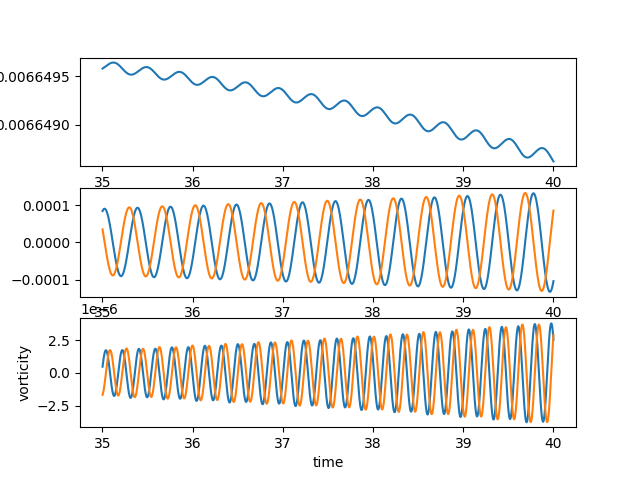Supercritical Hopf bifurcation¶
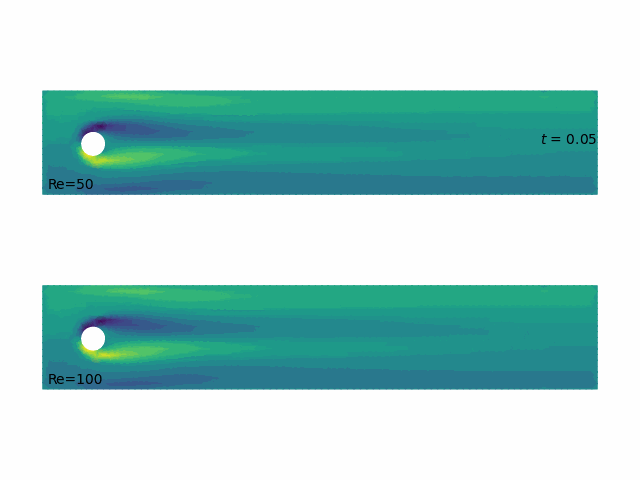
- Unsteady Navier–Stokes solutions by
scikit-fem(Gustafsson & GDMcB 2020)
Point-probe vorticity in near wake¶
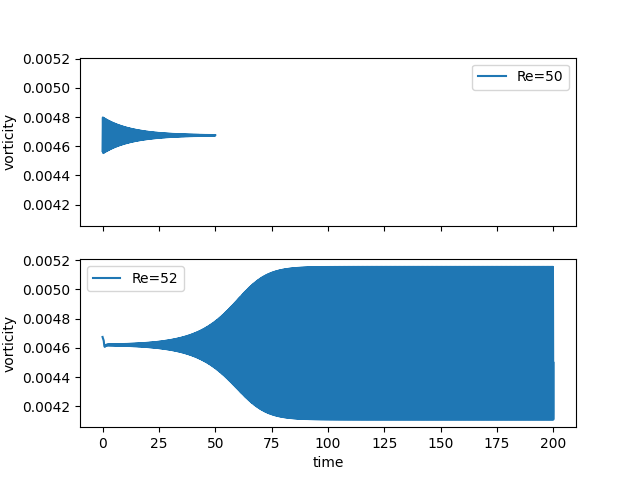
Point-probes: the supercritical periodic oscillations¶
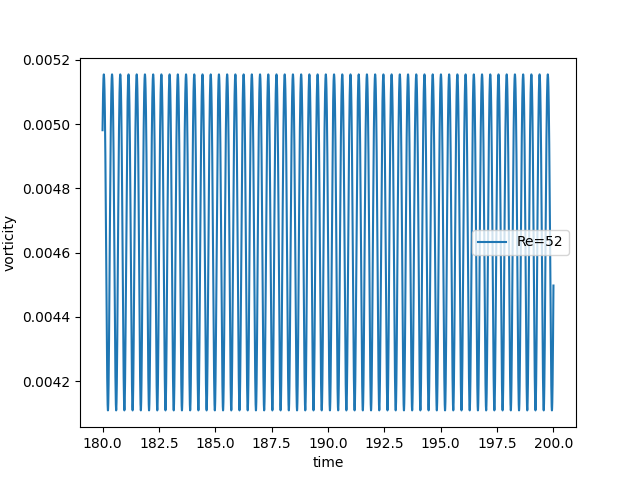
Point-probes: exponential growth from equilibrium¶
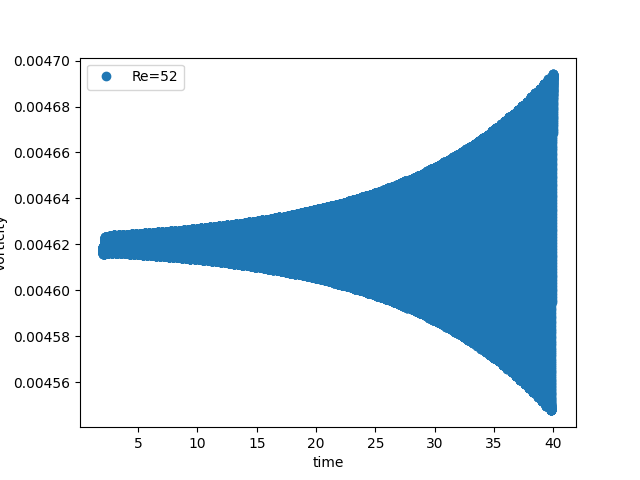
Point-probes: exponential decay to equilibrium¶

Periodic point-probes: Fourier analysis?¶
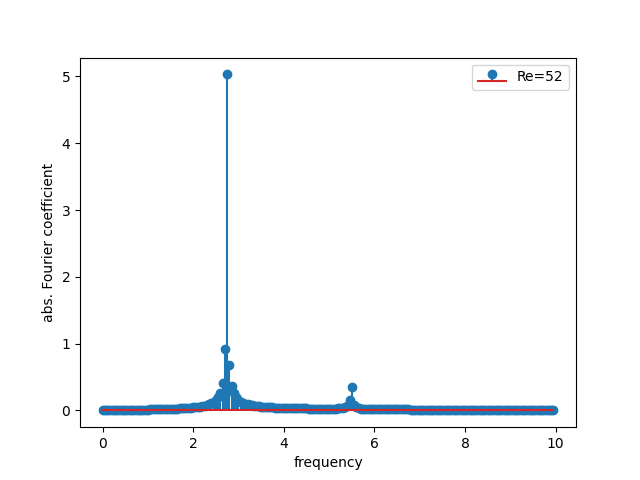
Periodic point-probes: autoregression¶
- AR(p): $y_k = b_0 + b_1 y_{k-1} + b_2 y_{k-2} + \cdots + b_p y_{k-p}$
- solve for coefficients by least-squares
- constant term: $y_\infty = b_0 / \left(1 - b_1 - b_2 - \cdots - b_p\right)$
- modes: $y_k - y_\infty \sim a\mu^k$
- characteristic polynomial: $b_p + b_{p-1} \mu + \cdots + b_1\mu^{p-1} - \mu^p$
- complex growth-rate: $s = \left(\log \mu\right) / \Delta t$
- growth rate and angular frequency: $s = \sigma + \mathrm i\omega$
Periodic point-probes: AR v. FFT¶
- FFT
- frequency is discretized ± 0.05!
- 0.05 = 1/20 = 1/duration
- frequency–time uncertainty: energy is smeared out
- f = 2.75, 5.50, …
- frequency is discretized ± 0.05!
- AR(4):
- best frequency estimates, not discretized
- a Prony coefficient contains all the energy of each mode
- f = 2.742, 5.486, …
AR(p) for periodic point-probes¶
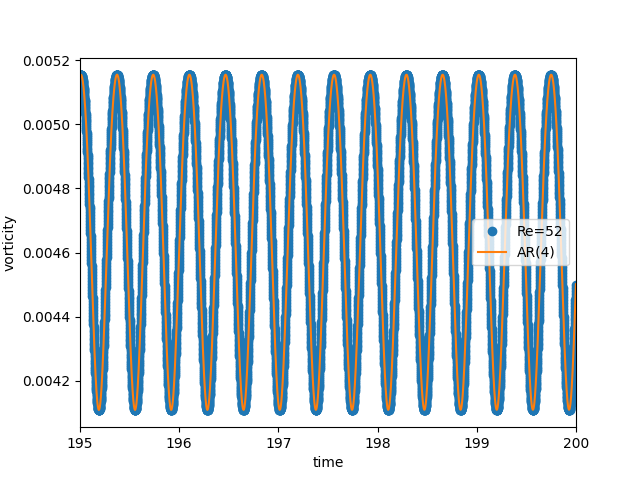
Periodic point-probes: AR for linear growth¶
- Near the bifurcation point we expect behaviour like $\mathrm e^{st} = \mathrm e^{\sigma t}\mathrm e^{\mathrm i\omega t}$ with |σ| ≪ ω
- This too is just as amenable to autoregression
- FFT is useless
- AR gives both growth rate and frequency:
- real and imaginary parts of roots of characteristic equation
AR(p) for unstable point-probes¶
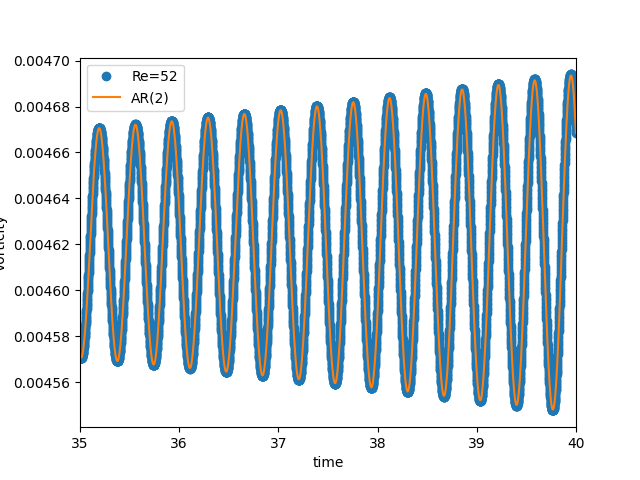
AR(p) for stable point-probes¶
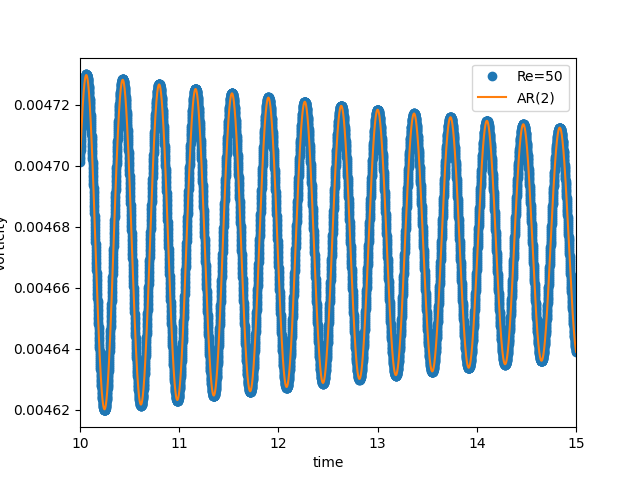
Fourier v. Prony analysis¶
- Fourier analysis: series of trigonometric polynomials or complex exponentials of unit modulus
- Prony analysis: series of general complex exponentials $\mu = \mathrm e^{s\Delta t}, s = \sigma + \mathrm i\omega$
- Prony, R. (1795). Essai Experimental et Analytique sur les lois de la Dilatabilité de fluides élastiques et sur celles de la Force expansive de la vapeur de l'eau et de l'alkool, à différentes températures. Journal de l'école polytechnique, 1:24–76.
Prony analysis¶
Three steps:
- autoregression: $\{y_k\}\rightarrow \{b_\ell\}$, least squares $$y_k = b_0 + b_1 y_{k-1} + b_2 y_{k-2} + \cdots + b_p y_{k-p}$$
- eigenvalues: $\{b_\ell\}\rightarrow \{\mu_m\}$, roots of characteristic AR polynomial $$b_p + b_{p-1}\mu + \cdots + b_1 \mu^{p-1} - \mu^p$$
- Prony coefficients: $\left(\{y_k\}, \{\mu_m\}\right)\rightarrow \{a_n\}$, least squares, again $$y_k = y_\infty + a_1 \mu_1^k + a_2 \mu_2^k + \cdots + a_p \mu_p^k$$
Vector Prony Analysis¶
What if we wanted to apply this to more than just a point-probe?
- AR → VAR
- roots of characteristic polynomial → polynomial eigenvalue problem
- coefficients → still least squares, just bigger
Vector Prony Analysis, 1: VAR(p)¶
- Vector autogression (VAR(p)) is well established, particularly in econometrics.
- AR: $y_k = b_0 + b_1 y_{k-1} + b_2 y_{k-2} + \cdots + b_p y_{k-p}$
- VAR: $\mathbf y_k = \mathbf b_0 + \mathsf B_1 \mathbf y_{k-1} + \mathsf B_2 \mathbf y_{k-2} + \cdots + \mathsf B_p \mathbf y_{k-p}$
- Used to investigate time-series which may be interdependent.
- Straightforward.
- Many implementations available
- e.g.
statsmodels.tsa.vector_arin Python
- e.g.
- References:
- Lütkepohl, H. (1991). Introduction to multiple time series analysis., Springer
- Wikipedia, ‘Vector autoregression’
Vector Prony Analysis, 2(a): PEP, derivation¶
- characteristic polynomial of AR: substitute $y_k - y_\infty = \mu^k$ into AR's homogenized recurrence relation
- $b_p + b_{p-1}\mu + \cdots + b_1 \mu^{p-1} - \mu^p$
Generalization to VAR?
First find fixed-point of recurrence relation:
- Then subtract it to homogenize: $\mathbf z_k = \mathbf y_k - \mathbf y_\infty$ $$\mathbf z_k = \mathsf B_1 \mathbf z_{k-1} + \mathsf B_2 \mathbf z_{k-2} + \cdots + \mathsf B_p \mathbf z_{k-p}.$$
- Try $\mathbf z_k = \mu^k\mathbf u$: $$\left[\mathsf B_p + \mu\mathsf B_{p-1} + \cdots + \mu^{p-1}\mathsf B_1\right]\mathbf u = \mu^p\mathbf u$$
- a Polynomial Eigenvalue Problem (PEP)
Vector Prony Analysis, 2(b): PEP, solution¶
$$\left[\mathsf B_p + \mu\mathsf B_{p-1} + \cdots + \mu^{p-1}\mathsf B_1\right]\mathbf u = \mu^p\mathbf u$$- Typically convert to standard eigenvale problem $\mu\mathbf v = \mathsf C\mathbf v$ via companion matrix C:
Vector Prony Analysis, 3: LS¶
- Vector Prony: $$\mathbf y_k = \mathbf y_\infty \sum_\ell a_\ell \mu_\ell^k \mathbf u_\ell$$
- ‘dynamic modes’ u*ℓ*
- VAR/(HO)DMD eigenvalues μℓ
- Prony coefficients aℓ
- Determine vector Prony coefficients aℓ by least squares.
Dynamic mode decomposition¶
- Schmid, P. J. (2010). Dynamic mode decomposition of numerical and experimental data. J. Fluid Mech., 656:5–28
- DMD is vector autoregression VAR(1) without constant term!
Higher order dynamic mode decomposition¶
- Le Clainche, S. & Vega, J. M. 2017. Higher order dynamic mode decomposition. SIAM Journal on Applied Dynamical Systems, 16:882–925
- Vega, J. M., Le Clainche, S. 2020. Higher Order Dynamic Mode Decomposition and its Applications. Academic
- Looks like VAR(p)?
- But without constant term?
- VAR(p):
- VAR(p) is well-established; let's use proven VAR(p) algorithms
Vector compression¶
- VAR(p) on full CFD flow-fields would be expensive.
- DMD typically precompresses using proper orthogonal decomposition (POD)
- HODMD typically uses singular value decomposition (SVD)
- POD orthogonalizes w.r.t. kinetic energy or enstrophy
- SVD orthogonalizes in Euclidean norm of discrete vector space
- SVD = POD for uniform grids in finite difference or volume
- SVD ≠ POD for nonuniform grids or finite elements
- mass matrix not a scalar multiple of identity
Weighted SVD¶
- POD = weighted SVD
- requires Cholesky factor of mass matrix
- Possibly expensive and unavailable in
scipy.sparse.linalg! - Try lumped mass matrix.
- diagonal
- trivially factorized
- finite elements: use vertex-based quadrature
- Compromise between efficiency & expense of compression.
Weighted SVD: implementation¶
- mass matrix M
- vorticity ω
- enstrophy ωT M ω
- Cholesky: M = RTR
- enstrophy: (R ω, R ω) = ‖R ω‖²
- weighted SVD: (RY) Σ WT =
svd(R ω)- Y = R−1 (RY)
- Python, assuming M diagonal:
In [ ]:
R = M.sqrt()
RY, Sigma, W = svds(R @ vorticity, k)
Y = R.power(-1) @ RY
Summary of our HODMD¶
- Cholesky factor lumped mass matrix
- Compress: weighted SVD of snapshots of flow-fields from CFD (e.g. vorticity)
- VAR(p): compute vector-autoregression coefficients, including constant term
- Vector Prony modes: PEP
- Vector Prony coefficients: least squares (least squares again)
- Should work well for same cases as AR(p) on point-probes:
- eventual periodic state past supercritical Hopf bifurcation
- exponential growth from steady state when Re > Rec
- exponential decay to steady state when Re < Rec
POD v. Prony¶
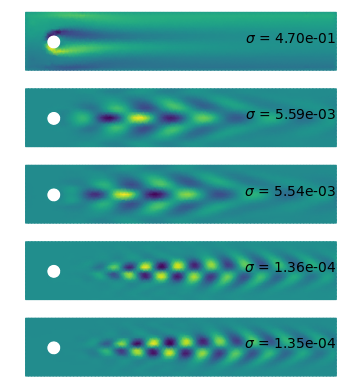
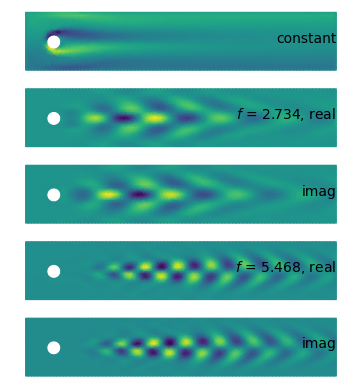
Conclusions¶
In supercritical Hopf bifurcations:
- point-probes:
- Prony is better than FFT for identifying frequencies in periodic signals
- Prony can also extract frequency from exponentially modulated oscillations
- And the growth or decay rate
- full flow-field structural analysis
- POD can be cheaply approximated using Cholesky factor of lumped mass matrix
- vector Prony is much like HODMD
- (HO)DMD should use established VAR(p)
- including including the constant term
- vector Prony gives modes with growth rate & frequency
- whereas POD modes have arbitrary chronoi
- oscillatory Prony modes are exact conjugate pairs
- Prony spatially do roughly resemble POD in cases considered

